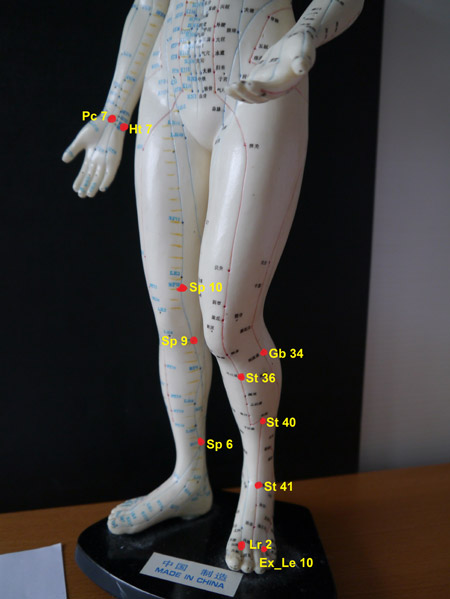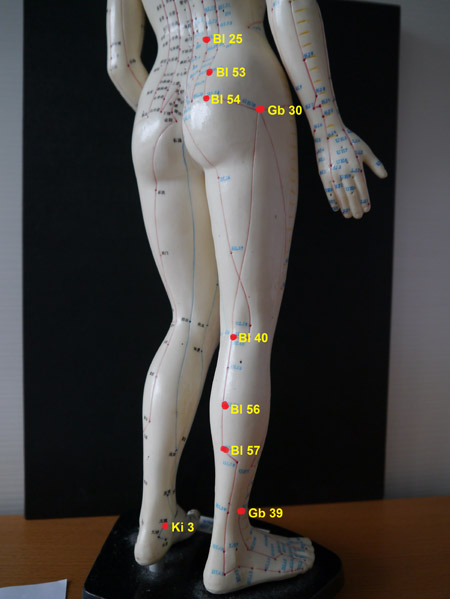|
Individuals with restless legs syndrome (RLS) have uncomfortable sensations deep inside the legs, and an irresistible urge to move the legs so as to make the discomfort go away. The sensations usually occur in both legs, the arms or other parts may be affected occasionally. The symptoms are most apparent at rest, especially when lying or sitting, leading to sleep deprivation and stress. Also, nighttime leg twitching is common in the individuals.
Restless Legs Syndrome (RLS) is categorized as a neuropathy disorder, and research has suggested that it may be due to an imbalance of the neural chemical messengers.
Acupuncture mediates neuro-hormonal activities, which induce multilevel responses of the body system. This treatment modality relies on appropriate acu-points selection, and stimulation techniques such as twirling, flicking, lifting, and thrusting as well as applying heat or a weak electrical current to enhance the effects. The application procedures vary according to acupuncturists.
Acupuncture is the major form of RLS treatment in traditional Chinese medicine (TCM). According to the symptoms of RLS, such as aching, numbness, heaviness or abnormal movements of the limbs, the problem is regarded as "bi-syndrome" which resulted from long-term obstructive problems in the leg meridians. Development of RLS is also associated with protective qi disturbance inside the body (See how protective qi is related to sleep). Protective qi flows through the extremities, between the skin and muscles, its circulation determinates the sleep and wake cycle of the body. Under normal circumstances, the protective qi flows along the yang meridians in the daytime which enables the organs to function actively and remains awake. On the other hand, protective qi flows along the yin meridians at night, thus the body becomes inactive and needs to sleep. Because of pathogenic accumulation in the extremities, the flow of protective qi is disturbed, it can't enter the yin portion of the body to promote sleep, and instead it stagnates in the extremities, and causes RLS symptoms as well as sleep problem.
Acupuncture treatment for RLS aims to nourish and invigorate the liver and kidney, regulate blood and qi (vital energy) activities, unblock and promote the meridian flow in the legs. Physicians will select the body points based on the symptom patterns of the individuals, which usually focus along the meridians in the lower limbs. Below are some acupuncture treatment protocols for RLS.
Point selections |
Stimulation methods |
Analysis |
zu san li (St 36)
yang ling quan (Gb 34)
da ling (Pc 7)
cheng shan (Bl 57)
|
Needling stimulation on both sides. After getting the needling sensations, retain the needles for 30 minutes and apply moxa heating on St 36 and Bl 57. Apply daily for 10 days as a course of treatment. Then apply every 2 days for 10 times as consolidating treatment. |
St 36 is the qi gather point of the leg meridians, while Bl 57 is specialized in releasing the calf muscle, these two points help promote qi flow and functional activity of the low limbs. In addition, moxa heating on them not only can enhance the needling effects, but also dispel the localized pathogens. Pc 7 is the source point of the pericardium meridian, and it helps regulate the blood flow as well as calm down the body. Gb 34 is the influential point of tendons, which helps promote tendon health. |
gan shu (Bl 18)
shen shu (Bl 23)
huan tiao (Gb 30)
yang ling quan (Gb 34)
zu san li (St 36)
wei zhong (Bl 40)
cheng shan (Bl 57)
san yin jiao (Sp 6)
shen men (Ht 7)
|
Stimulating both sides. After getting the needling sensations, retain the needles for 30 minutes. Apply daily, 10 times as a course of treatment, rest for 2 days, and start another course if necessary. |
The points work together to reinforce liver and kidney, promote blood and qi production, unblocks meridians and calm down spirit.
 |
Bl 18 & Bl 23: invigorate the liver and kidney systems; |
 |
St 36: replenishes blood and qi; |
 |
Gb 34: loosens tendons and unblocks the collaterals of the legs; |
 |
Ht 7: calm down the spirit; |
 |
Gb 30: relieves weakness, numbness and pain in the lower limbs; |
 |
Sp 6: enhances the overall therapeutic effects; |
 |
Bl 57 & Bl 40: promote the meridian flow and relieve muscle cramps in the lower limbs. |
|
zu san li (St 36)
san yin jiao (Sp 6)
yang ling quan (Gb 34)
cheng shan (Bl 57)
shen shu (Bl 23)
da chang shu (Bl 25)
|
Stimulating on both sides, needle retention for 30 minutes, and moxa heating on Gb 34. Apply daily, 10 times as a course of treatment. |
The major points are mainly along the three meridians of the legs, including the Stomach, Bladder and Spleen Meridians, they work together to replenish blood and qi, promote circulation, resolve stasis, loosen tendons and unblock meridians.
 |
Bl 23, 25, & 57: smooth the meridian flow, nourish blood and expel localized pathogens in the lower limbs; |
 |
St 36 & Sp 6: invigorate the spleen and stomach to produce blood and qi; |
 |
Gb 34: nourishes the meridians, and loosens the tendons and muscles of the legs. |
|
xue hai (Sp 10)
cheng jin (Bl 56)
cheng shan (Bl 57)
san yin jiao (Sp 6)
zu san li (St 36)
wei zhong (Bl 40)
yin ling quan (Sp 9)
yang ling quan (Gb 34)
xuan zhong (Gb 39)
xing jian (Lr 2)
|
Select 3-5 points each time, stimulate on both sides. After getting the needle sensations, retain the needles for 30-40 minutes. Apply daily, 10 times as a course of treatment, rest for 3 to 5 days, start another course if necessary. |
 |
Sp 9, Bl 40, Gb 34, Gb 39 & Lr 2: clear heat, induce urination to eliminate internal dampness, and also loosen tendons and activate blood; |
 |
Sp 6 & St 36: promote the spleen and stomach to produce more blood and qi, and regulate blood and qi activities; |
 |
Sp 10: replenishes essence and marrow for the bone; reinforces liver and kidney |
 |
Bl 56 & Bl 57: unblock meridians and promote the flow of blood and qi of the lower limbs. |
|
Group 1:
zu san li (St 36)
cheng shan (Bl 57)
xuan zhong (Gb 39)
Group 2:
yang ling quan (Gb 34)
jie xi (St 41)
san yin jiao (Sp 6)
Group3:
wai qiu (Gb 36)
wei zhong (Bl 40)
ba feng (Ex-Le 10)
|
Each time select one group of points for stimulation, stimulate on both sides. After getting needling sensations, retain the needles for 30 minutes, moxa heat on each needle for 5 minutes. Apply daily, 10 times as a course of treatment. |
 |
Gb 39: clears heat in the gallbladder meridian and bone marrow, loosens tendons and relieves pain in the lower limbs; |
 |
St 41: river point of the stomach meridian, which helps unblock and activate the collaterals, clear stomach heat, resolve phlegm and calm down the spirit. It is specialized in relieving numbness, weakness, and muscle wasting of the lower limbs; |
 |
Gb 36: regulates the liver meridian and qi flow, unblocks collaterals and calms down the spirit. It is commonly used in lower limb problems. |
 |
Ex-Le 10: this is specialized in relieving soreness, pain, swelling and numbness of the feet. |
|
Major points:
jia ju (Ex-B2) at L4-5
jia ju (Ex-B2) at L5-S1
Associated points:
yao yi (Ex-B6)
bi zhong (Ex-Ue)
bao huang (Bl 53)
zhi bian (Bl 54)
huan tiao (Gb 30)
|
Stimulating both sides. After getting the needling sensations, retain the needles for 30 minutes. Apply daily, 10 times as a course of treatment. |
Point selections are also compliable with the nerve distributions of the spine and limbs. |
wei zhong (Bl 40)
xue hai (Sp 10)
cheng shan (Bl 57)
yang ling quan (Gb 34)
xing jian (Lr 2)
|
Stimulating on both sides. After getting the needling sensations, retain the needles for 30 minutes. Apply daily, 10 times as a course of treatment. |
|
xue hai (Sp 10)
yang ling quan (Gb 34)
san yin jiao (Sp 6)
tai xi (Ki 3)
zu san li (St 36)
wei zhong (Bl 40)
cheng shan (Bl 57)
|
Stimulating on both sides. After getting the needling sensations, retain the needles for 10 minutes. Apply daily or every two days, 7 times as a course of treatment, rest for 3 to 5 days, start another course if necessary. |
|
a-shi points
zu san li (St 36)
feng long (St 40)
san yin jiao (Sp 6)
xue hai (Sp 10)
wei zhong (Bl 40)
yang ling quan (Gb 34)
|
Stimulating on both sides. After getting the needling sensations, retain the needles and moxa heat on each needle for 30 minutes. Apply every two days, 7 times as a course of treatment, rest for 3 to 5 days, and start another course if necessary. |
St 40: a point on the stomach meridian, it helps harmonize the stomach, resolve phlegm and dampness, and calm the spirit. |
RLS individuals should note that even though the symptoms disappeared after acupuncture treatment, they should keep treating for a period of time, so as to consolidate the therapeutic results. For the elder individuals or stubborn cases, it is better in combination with herbal treatment. Prescriptions that contain herbs such as cyathula root, suberect spatholobus stem, white peony root, angelica root, processed rhemannia rhizome, and largehead atractylodes rhizome are beneficial. The ingredients help regulate the internal organs and invigorate their functioning.
 |
| Acu-points for restless legs syndrome |
 |
| Acu-points for restless legs syndrome |
|